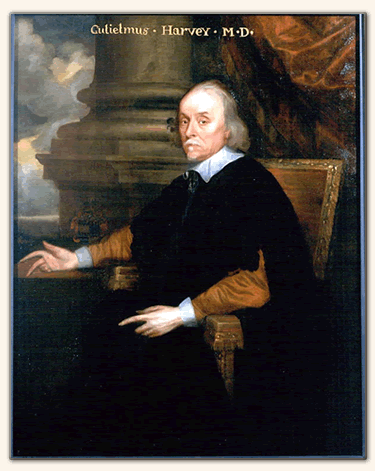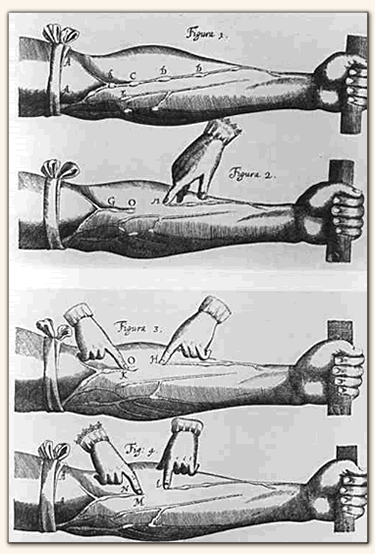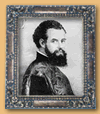
William Harvey

Plate Illustrating Harvey's
Experiments on the Human Forearm

Vesalius' System of Veins and Arteries

While anatomical science grew primarily on the continent, William Harvey (1578-1657) made the first major contribution to English Anatomy and forever changed the study of anatomy and physiology.1 His great work, An anatomical dissertation on the heart and blood in animals (1628, folio), truly revolutionized the study of the human body and physiology forever after. Born in Kent and educated at Caius College at Cambridge (1597) and the University of Padua under Fabrizio, Harvey was elected to the Royal College of Physicians in 1607. While he waited until 1628 to publish his work on circulation (his folio was published in Frankfurt), his lecture notes suggest that he had considered that blood might circulate throughout the body as early as 1603: “‘movement of the blood occurs constantly in a circular manner and is the result of the beating of the heart.’”2 Following Vesalius in advocating the primacy of ocular evidence, Harvey broke from Vesalian thinking: by applying concepts of physics to his study of the movement of blood in the body, he shed the notion that the body was the product of a grand design and adopted the position that the body operated as a machine.3 Moreover, he also advocated the belief that each organ has a specific function (or functions) which worked in relation to other organs in the body. In this respect, Harvey’s work was formative for later anatomists, including John Hunter. Earlier anatomists has focused on the discovery and description of the organs without investigating their purposes or uses in the body; in fact, many considered physiology best left to metaphysicians. Harvey, by focusing on both sides of the locate-interpret schism that modern subjects almost entirely gloss when considering contemporary anatomy, reintroduced physiology into the academy, giving it a prominence it had not enjoyed for over a millennium.4 Using what others had discovered (the structure of the heart had been known since Vesalius; the structure of veins, specifically their valves, had been unveiled by Fabrizio), Harvey conducted experience to determine not what the organs were, but how they worked and to what effect. By vivisecting serpents, Harvey carefully observed changes in the heart, including its coloration and its shape, as it contracted and expanded; he also noted changes in shape when he would briefly clamp arteries and pulmonary veins. Because he was interested in coordinate functions, or the way the body’s organs might work as a system, he also noted that the contraction of the heart coincided with the expansion of the arteries.5 Using his knowledge of valves in arteries, he understood that blood flowed unidirectionally from the heart, a fact that caused him to wonder how the body dispensed with the volume of blood that the heart pumped throughout it. By applying physical science to the problem, he determined that blood must flow unidirectionally, but continuously: he was staggered by the sheer volume of blood that the heart would have to produce and distribute if the flow of blood terminated when it reached other organs, calculating that for a heart containing two ounces of blood that registered 72 beats-per-minute, in one hour the heart would introduce 255.5 liters of blood into the body.6 Through further experimentation and demonstration, both on serpents and superficially on the arteries and veins in the normative human arm, Harvey was able to conclude that “ ‘All things, both argument and ocular demonstration, thus confirm that the blood passes through the lungs and heart by the force of the ventricles, and is driven thence and sent forth to all parts of the body. …It is therefore necessary to conclude that the blood in the animals is impelled in a circle, and is in a state of ceaseless movement; that this is the act or function of the heart, which it performs by means of its pulse; and that it is the sole and only end of the movement and pulse of the heart.’”7 By applying physics to the study of physiology, Harvey reframed the body as a machine, establishing an anatomico-physiological foundation for later Enlightenment materialist discourse and encouraging Enlightenment anatomists to continue his type of work in the fields of iatrophysics and iatrochemistry.8 Iatrophysicists like the Pisan Giovannia Borelli (De motu animalium, 1680) studied muscle behavior, the functions of the glands, heart action, and respiration, while his younger colleague Girogio Baglivi, later a professor of anatomy at Rome, proclaimed that “‘A humn body, as to its natural actions…is truly nothing else but a complex of chymico-mechanical motions, depending on such principles as are purely mathematical.’”9 |
![]()



